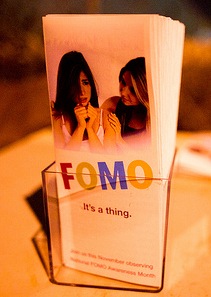
Last summer I read a NY Times article about MoMA’s “Rain Room” installation. (Steamy Wait Before a Walk in a Museum’s Rain) The installation itself sounded interesting, a room that “rains” but knows where people are and doesn’t rain on them. In other words, no one gets wet. Fascinating technology and an intriguing experience.
However, what really struck me was the new concept I learned reading the article: FOMO, Fear of Missing Out. One interview subject said, “A lot of people have this syndrome,” . . . while waiting in line on Saturday. “That’s why we don’t sit in our apartments.” This installation tapped into that fear in spades. The crowds were huge, the lines extremely long.
Which, of course, made me think, “How can the arts tap in to FOMO?” An obvious immediate response for most of us in the industry would be that the arts, by their nature, are compelling and so should be able to do so easily. However, evidence indicates that this is not the case.
In Inspire, Delight, and Surprise, I described how all our work should be doing at least two of those three things. A mindset to deliver inspiration, delight, and surprise can connect us with our audiences, our communities in significant ways. Adding to this the new (to me) concept of FOMO, we have an interesting “metric.” When our work is connecting, is inspiring, delighting, surprising, we will have created FOMO. We will observe crowds clamoring to participate in the experiences we offer. If FOMO has been tapped in significant ways, we will be SRO (standing room only, not single room occupancy!) with regularity. Not being so does not mean we have done something wrong; it may, however, mean we have not done some things as right as possible.
Both my IDS framework and a mindset seeking to create FOMO help us focus on the people in our communities we seek to reach. They can serve as an effective antidote to artcentricity and help us strengthen relationships with our communities as well as our own viability.
——————
On another note, Art of the Rural has announced its 2014 initiative The Year of Rural Arts. Communities come in all kinds and sizes. Indeed, many of the best examples and early history related to community engagement come from rural areas. I’m aware of this largely as a result of my role on the board of the Robert E. Gard Foundation. The Foundation will be working with Art of the Rural on a project that I’ll be highlighting soon.
——————
And another . . . . Please join me in welcoming Lynn Conner as an ArtsJournal blogger. Her new blog, “We the Audience,” focuses on the relationship between audiences and the art they experience. Long time (very long time) readers of Engaging Matters may recall mention of her book here in Things Change. We look forward to her thoughts.
Engage!
Doug
- Photo:


 Some rights reserved by y3rdua
Some rights reserved by y3rdua
